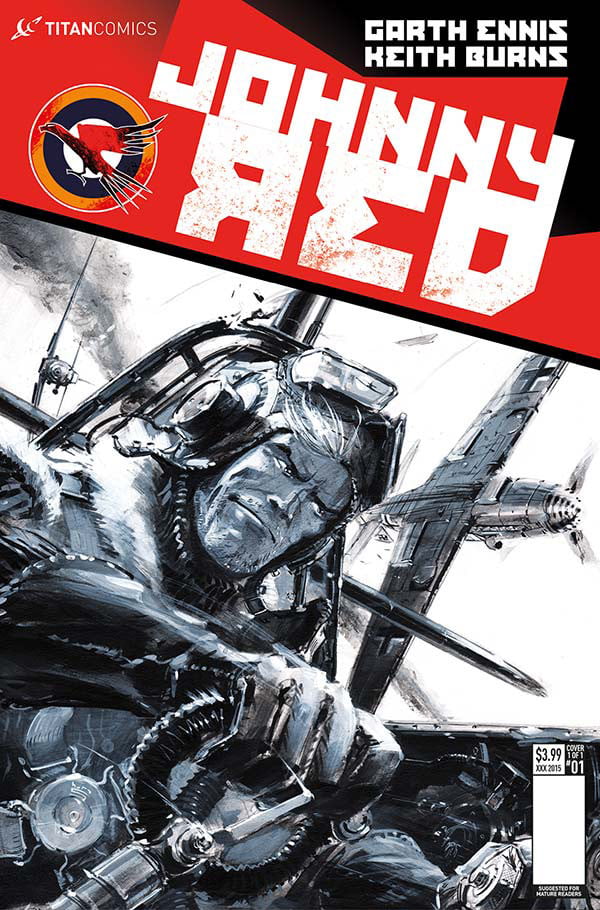Written by Garth Ennis
Art by Keith Burns
Colours by Jason Worde
Letters by Ron Steen
Edited by Steve White
Published by Titan Comics
Tony Iverson is a young, wealthy man (he made his money in the dot com boom) who has come to Vintage Flyers in Suffolk so that they can restore P7089: the battered and beaten airframe of a Hurricane plane (‘the plane that won the Battle of Britain while the Spitfire got the credit’). It has a strange history and the wreckage was recently found in Eastern Germany – for more details, Iverson will have to go to Russia to make further enquiries with a specialist contact. The contact in Russia locates a veteran of ‘the Great Patriotic War’ who says he knows Iverson’s plane, a former sergeant called Rodimitz. After laughing himself silly at the price Iverson paid for the Hurricane, Rodimitz (‘I would been happy to burn that worthless, stupid, obsolete English shitbox to the ground’) tells Iverson that he was Chief Mechanic of the fighter squadron the Hurricane flew with, and proceeds to tell him the ‘secret’ story of that time.
With that, the story flashes back to Stalingrad during the Second World War, where millions of Russians have died and those who remain survive and fight, and all planes were drafted to drop supplies so that the Russian defenders could continue the fight. However, the better German planes with their better pilots were always waiting … Fortunately, there was one plane that even the German fighter pilots recognised, a British plane flown by an Englishman leading a Russian squadron of which there is no record due to the story Rodimitz is going to tell Iverson …
Ennis is a fantastic writer of war stories (in my thoughts on Punisher: Valley Forge, Valley Forge, I mentioned that the prose extracts of a factual book about the war were fantastic and that I would read non-comic-book war stories written by Ennis) as well as a huge war geek, as he has demonstrated in his various collections of his war comics. He is also a huge fan of Johnny Red, so this must be a dream come true for him. This comes across in the writing – he cannily starts the book in the present day so that he can slip in his war-buff knowledge before making the transition to the original era, but it also allows him to set the story up in a way to draw in a modern crowd, highlighting the unusual setting of a British pilot fighting with the Russians on the Eastern Front. The material at the back relates how a real event was the inspiration for the original Johnny Red stories (although the unfortunate typos take away some of the gravity: ‘… or make for distance [sic] Russian. He sensibly opted for the later [sic] …’); although this is fiction, Ennis grounds it in the reality of the war and all the horror it involved.
Ennis also uses the build-up technique before the reveal, which is a nice touch and works even though the reader knows that the character is Johnny Red – the deliberate hiding of his face in various panels until the final page reveal (where he is corrupting a 17-year-old boy: ‘It’s time you started smoking.’) is a handsome way to introduce and set up the protagonist. The art by Burns is a fine assist in this regard: using different camera angles to delay showing Johnny Red’s face while still making that seem natural and telling the story at the same time is a tough trick to pull off, but Burns does so with aplomb. There’s a certain rough line to Burns’ style, particularly in the faces, but his attention to detail when it comes to the aeroplanes is anything but rough, something I’m sure was important for Ennis in this collaboration. The aeroplane battles are also impressive, dynamic and vibrant yet clear and easy to follow.
I continue to be impressed with how effortless Ennis’ writing appears – each timeframe has wonderfully natural dialogue that advances the story while dropping in important information and maintaining different styles between the different eras, as well as identities for the different nationalities without needing linguistic tics to achieve it. I have read (and reviewed) some of the previous Johnny Red stories, so I know a little of what to expect, and this new comic book feels exactly in the same vein as the original material. I hope the modern comic book industry has room for a boys-own adventure, because Johnny Red is off to a flying start (and I don’t apologise for that terrible pun).




